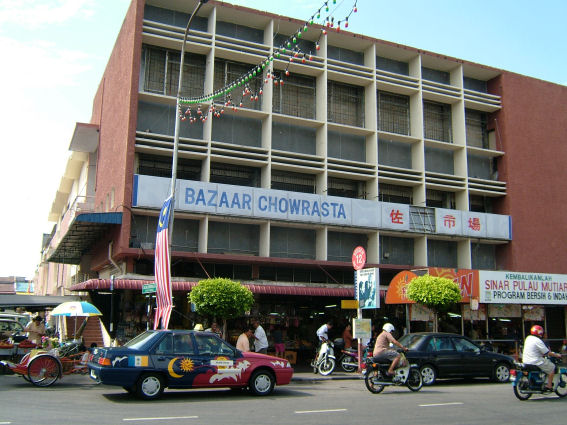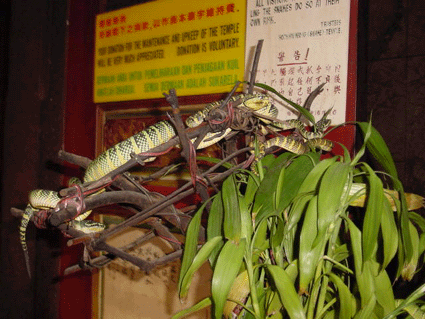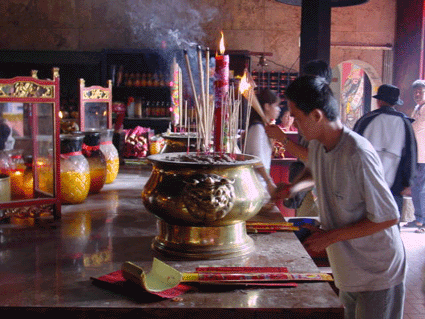KOMTAR - Penang Iconic Landmarks
 Penang is synonymous with good and relatively affordable hawker food, beautiful beaches and hotels, heritage buildings, tree-lined streets and a multitude of interesting and mesmerizing cultural sights. These, and the fairly laid-back lifestyle of penangites, make the island an enjoyable place for holidays among locals as well as foreigners.Dominating the island’s skyline is KOMTAR (Kompleks Tun Abdul Razak) the famous landmark of Penang and touted to be the icon of its urban renewal programme. With the cost of RM207 million, the 65-storey building was the tallest in Asia at that time.The buildings consist of a 12-sided geometric block, 760ft (232m) tall and sitting atop a 4-storey podium. The complex comprises office and retail commercial space as well as public and recreational facilities.
Penang is synonymous with good and relatively affordable hawker food, beautiful beaches and hotels, heritage buildings, tree-lined streets and a multitude of interesting and mesmerizing cultural sights. These, and the fairly laid-back lifestyle of penangites, make the island an enjoyable place for holidays among locals as well as foreigners.Dominating the island’s skyline is KOMTAR (Kompleks Tun Abdul Razak) the famous landmark of Penang and touted to be the icon of its urban renewal programme. With the cost of RM207 million, the 65-storey building was the tallest in Asia at that time.The buildings consist of a 12-sided geometric block, 760ft (232m) tall and sitting atop a 4-storey podium. The complex comprises office and retail commercial space as well as public and recreational facilities.
KOMTAR occupies an 11-hectare site and is the single most ambitious project undertaken by Penang Development Corporation, the development arm of the Penang state government. The project master plan is divided into five phases for implementation which includes the construction of KOMTAR, Geodesic Dome, 17-storey international hotel, 4-storey shopping podium, public buses interchange, 11-storey car park and the latest addition Prangin Mall in 1997 linked by two enclosed steel-glass pedestrian bridges.The complex is named in honor of the second Prime Minister of Malaysia, the late Tun Abdul Razak bin Hussein. The first piling of the building's phase one was done by Tun Razak himself on 1 January 1974. Part of the complex's first phase podium block was completed in 1978.The construction of the building itself was completed in 1988 and it was on that day onwards reigned supreme as the shopping paradise of Penang. The 4-storey shopping complexes nestled at the foot of the Komtar Tower, plays an important part of the overall integrated redevelopment of George Town together with its hotels and the office tower block, where the State Government is located, and an international exhibition centre. On the 58th floor is the viewing gallery where you can see the whole area around Georgetown.


View from the gallery at 58th floor
However, the supremacy of KOMTAR as a shopper’s paradise did not last long.The new millennium saw the completion and opening of two of the largest shopping centres on Penang Island, Prangin Mall and Gurney Plaza, and the setting of the stage for an exciting retail/shopping atmosphere. More is coming in such as Island Plaza, Midlands Park Centre, Tesco, Jaya Jusco and some others shopping malls in Penang mainland which brings in a better tenant-mix, increased professionalism in centre management, improved ambience and the new evolution in the design of shopping centre’s. The heat is definitely on to attract shoppers as a result of increasing competition in terms of new shopping centre’s and hypermarkets.Therefore, only the fittest will survive.As the results of this, KOMTAR was under tremendous pressure to attract shoppers like the olden days.
People seems to have better perceptions & favors the newer shopping malls which can provides them with one stop solution such as shopping, dining, entertainment and exciting exhibitions.Henry Butcher Malaysia valuation department assistant manager Yeoh Peng Hong said the value of KOMTAR’s shoplots had substantially dropped compared to prices 15 years ago. The value for those on the first and second floors has dropped by at least 30% to 40% and 10% to 20% for shoplots on the ground floor and third floor.He said drop in value was the result of poor maintenance, lack of facilities and the mushrooming of new shopping complexes on the island. Many vacant shop lots bear testimony to its decline as tenant moves out to others shopping complexes.Today, while you can still see some crowd at KOMTAR, it is probably made up of those going to the Government departments or looking for that odd retailer still plying its business around the slightly upgraded corridors there or some curious visitor who just want to see for themselves, the declining status of the once proud Penang iconic structure.





 Besides the impressive reclining Buddha, you can find many other smaller shrines of Buddha, and Thai deities. There is also series of painted images portraying story of the Lord Gautama Buddha. The floor of the temple is laid with tiles of lotus patterns - lotus is a symbol in Buddhism.
Besides the impressive reclining Buddha, you can find many other smaller shrines of Buddha, and Thai deities. There is also series of painted images portraying story of the Lord Gautama Buddha. The floor of the temple is laid with tiles of lotus patterns - lotus is a symbol in Buddhism. Admission to the Wat Chayamangkalaram temple is free, but do remember to remove your shoes before entering the temple grounds.
Admission to the Wat Chayamangkalaram temple is free, but do remember to remove your shoes before entering the temple grounds.
 Located directly across from Penang, Jerejak Resort and Spa is a wonderful stopover when you visit the Northern hub of Malaysia.
Located directly across from Penang, Jerejak Resort and Spa is a wonderful stopover when you visit the Northern hub of Malaysia. 
 Probably the only one of its kind in the world. The temple honours a resident named Chor Soo Kong, who had healing powers. He was a Buddhist monk, who moved to Penang. Some devotees from as far away as Singapore and Taiwan come to pray in the temple on Chor Soo Kong's birthday (the sixth day of the first lunar month). The temple was built in about 1850 and is dedicated to Char Soo Kong. The statue of the deified healer was brought to Penang by a monk from China. The legend is that this pious monk gave shelter to the snakes of the jungle; when the temple was completed, the snakes moved
Probably the only one of its kind in the world. The temple honours a resident named Chor Soo Kong, who had healing powers. He was a Buddhist monk, who moved to Penang. Some devotees from as far away as Singapore and Taiwan come to pray in the temple on Chor Soo Kong's birthday (the sixth day of the first lunar month). The temple was built in about 1850 and is dedicated to Char Soo Kong. The statue of the deified healer was brought to Penang by a monk from China. The legend is that this pious monk gave shelter to the snakes of the jungle; when the temple was completed, the snakes moved







